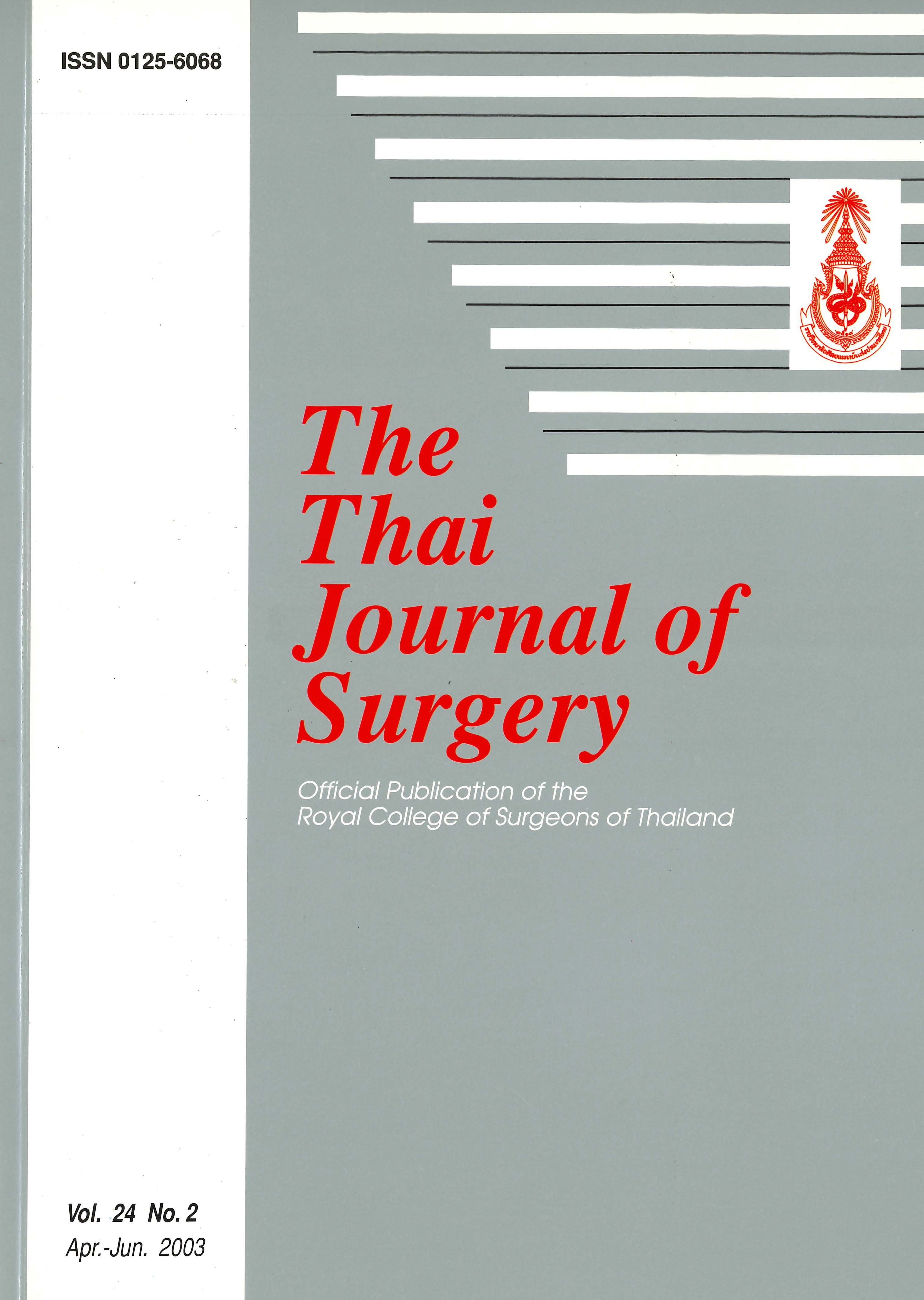Detection of Helicobacter bilis in Bile from Thai Patients with Adenocarcinoma of Biliary Tract
Abstract
Objectives: There is a high incidence of the biliary tract carcinoma in the Northern part of Thailand. Almost all of them are in advanced stage. Some data support an association of bile resistant bacteria, namely Helicobacter bilis which may play a causative role in the development of biliary tract carcinoma. Previous study had shown that animal infected with this bacteria developed malignant liver tumor. This study was designed to search for the Helicobacter bilis in bile that may play a causative role for malignancy of biliary tract.
Patients and Methods: From July to December 1999, bile samples were collected from 40 Thai patients with benign and malignant diseases of biliary tract who underwent surgical and radiological intervention in the Faculty of Medicine, Chiang Mai University. Collection of bile sample with sterile technique was obtained by sterile needle aspiration immediately after definitive procedures were performed for treatment. Patients who had antibiotics within 7 days before bile collection were excluded. Diagnostic evaluation, surgical procedures, and pathologic examination were reviewed. The specific part of DNA sequence of Helicobacter bilis were identified by PCR analysis and DNA sequencing in six random positive cases.
Results: Twenty six cases had benign diseases and 14 cases had malignant diseases. There were positive results by PCR analysis and DNA sequencing in 79 per cent (11/14) of malignancy cases and in 38 per cent (10/26) of benign cases. The positive rates of infection between malignancy and benign groups were statistically significant differences (p < 0.05). Identification of positive Helicobacter bilis was statistically significant compared with negative Helicobacter bilis in the malignant biliary tract diseases at an odds ratio of 2.04 (95%CI1.17-3.57).
Conclusion: Helicobacter bilis was found in human biliary tract malignancies of Thai patients. This bile resistant bacteria may be a risk factor in the pathogenesis of biliary tract malignancies.
References
2. Uttararvichen T, Buddhiswasdi V, Pairojkul C. Bile duct cancer and the liver fluke. Asian J Surg 1996; 19: 267-70
3. Mitacek EJ, Bruwnemann KD, Suttajit M, Martin N, Limsila T, Ohshima H, et al. Exposure to N-nitroso compounds in a population of high liver cancer region in Thailand: Volatile nitrosamine in Thai food. Food Chem Toxicol 1999; 37:297-305.
4. Satarug S, Haswell-Elkins MR, Sithithaworn P, Bartsch H, Ohshima H, Tsuda M, et al. Relationship between the synthesis of N- nitrosodimethlamine and immune responses to chronic infection with the carcinogenic parasite, Opisthorchis viverrini, in men. Carcinogenesis 1998; 19: 485-9
5. Srianujata S, Tonbuth S, Bunyaratvej S, Valyasevi A, Promvanit N, Chaiyatsagul W. High urinary excretion of nitrite and N-nitrosoproline in Opisthorchiasis subjects. IARC Sci Publ 1987: 84:544-6,
6. Schwartz DA. Helminths in the induction of cancer: Opisthorchis Viverrini, Clonorchis sinensis and Cholangiocarcinoma. Trop Geogr Med 1980; 32: 95-100.
7. Jonsukskuntigul P, Imsomboon T. The impact of a decade long opisthorchiasis control program in Northeastern Thailand. Southeast Asian J Trop Med Public Health 1997;28:551-7.
8. Suto T, Habano W, Sugai T, Uesugi N, Funato O, Kanno S, et al. 'Abberration of the K-ras, p53, and APC genes in extrahepatic bile duct cancer. J Surg Oncol 2000; 73: 158-63.
9. Fox JG, Yan LL, Dewhirst FE, Paster BJ, Shames B, Murphy JC, et al. Helicobacter bilis sp, nov., a novel Helicobacter species isolated from bile, livers, and intestine of aged, inbred mice. J Clin Microbiol 1995; 33: 445-54.
10. Fox JG, Dewhirst FE, Shen Z, Feng Y, Taylor NS, Paster BJ, et al. Hepatic Helicobacter species identified in bile and gallbladder tissue from Chileans with chronic cholecystitis. Gastroenterology 1998; 114: 755-63.
11. Rudi J, Rudy A, Maiwald M, Stremmel W. Helicobacter sp. are not detectable in bile from German patients with biliary disease (Correspondance), Gastroenterology 1999; 116:1016.
12. Sambrook J, Fritsch E, Maniatis T. Molecular cloning: a laboratory manual. 2nd ed. Cold Spring Harbor, N.Y.: Cold Spring Harbor Laboratory Press; 1989. p. 9.16-9.19.
13. Fritz SB, Westblom TU. PCR for the detection of H. pylori in gastric juice aspirates and environmental water samples: Helicobacter pylori protocol. Totowa, New Jersey: Hamana Press Inc.; 1997. p. 37-40.
Downloads
Published
How to Cite
Issue
Section
License
Articles must be contributed solely to The Thai Journal of Surgery and when published become the property of the Royal College of Surgeons of Thailand. The Royal College of Surgeons of Thailand reserves copyright on all published materials and such materials may not be reproduced in any form without the written permission.



